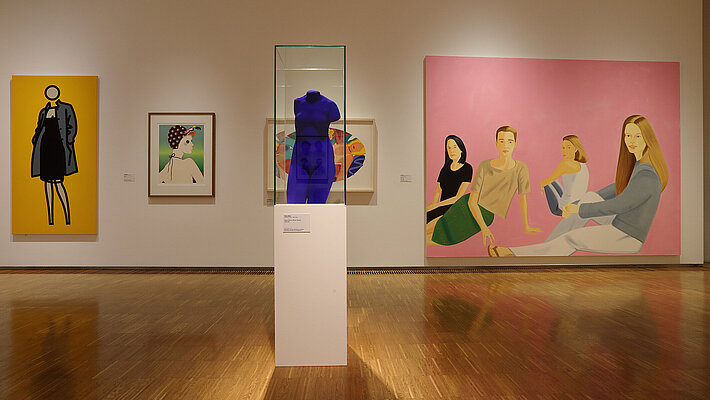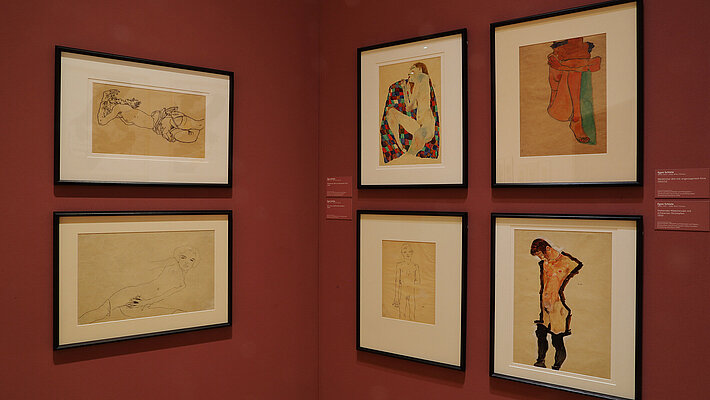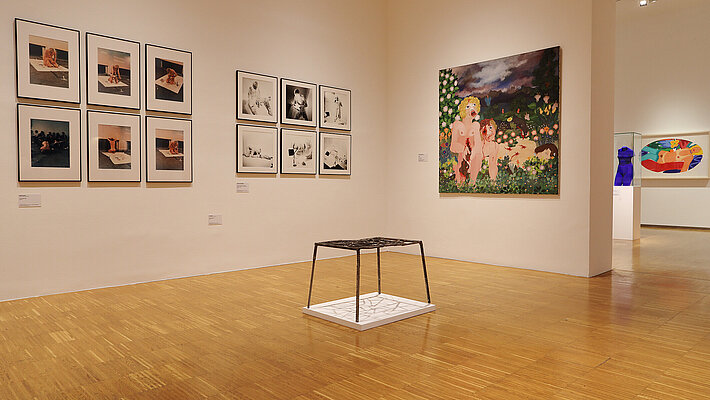|
|
|
|
|
|
Graz, Austria, 23.04.2024
Some 300 works from the Neue Galerie Graz Collection can be seen in the exhibition "Show!". These include both new acquisitions of recent years as well as highly prominent artworks that range narratively from 1800 to the present day. This time span, in which our habitat and humans themselves have changed so often and so fundamentally, has produced important and stirring pictures; it has thus held up a mirror multiple times, establishing ideals which are then destroyed in the next moment.
The exhibition’s goal is not to create a new canon, and certainly not to rearrange a hierarchy. Rather, the Neue Galerie shows a gallery tour of high quality, one it is proud of. Not least of all, this accords with what the public wants.
|
|

"Show!" presents around 300 outstanding works from the collection of the Neue Galerie Graz, including works by artists such as Kiki Kogelnik, Julian Opie, Tom Wesselmann, Alex Katz and Yves Klein, as seen here, photo: Universalmuseum Joanneum/J.J. Kucek
|
|
|
|
|
|
|
|
|
|
|
|
In recent years, the Neue Galerie Graz collection, comprising more than 70,000 works, has been shown partially, through variously themed exhibitions – for example, concerning the landscape, the portrait, feminist art. This time, not least in response to the strong desire of the public, an overview of the collection’s ‘highlights’ is on offer: an experimental gathering of works from the 19th century up to the present day.
From ‘masterpiece to highlight’
But what are ‘highlights’, who determines this status and how do works of this kind differ from others? Assuming the most obvious, these are widely known works by mostly renowned artists. However, it can also be assumed that a general consensus exists which suggests such designations. Museums founded in the 19th century were confronted with the question of the ‘masterpiece’. Suddenly, it was no longer for extravagant patrons to build collections in line with their personal inclinations, but for state-employed art guardians. They had to decide what should be shown in the museum, above any personal taste – in the name of history, as it were. As art is difficult to evaluate, the term ‘masterpiece’ was employed. . Today the term ‘highlight’ is applied in a similar way. We know what we are talking about, but we do not usually do it at the same time.
|
|

Works by Egon Schiele are also highlights in the collection of the Neue Galerie Graz, photo: Universalmuseum Joanneum/J.J. Kucek
|
|
|
|
|
|
|
|
|
|
|
|
On the history of the Neue Galerie Graz Collection
Apparently, ‘highlights’ are still created in a variety of ways. They follow the art-historical definition, market reality and subjective individual views, and thus fulfil a broad consensus. Waldmüller, Egner, Blau, Wisinger-Florian, Klimt, Schiele, Boeckl, Warhol, Lassnig, Brus, Jungwirth – all these artists represent ‘highlights’. They enjoy a special status within the Neue Galerie’s collection, they carry the prominence of the collection, so to speak.
Enormous progress was made both with the BRUSEUM and through targeted new acquisitions of international art under Christa Steinle, Peter Weibel and Werner Fenz. Driven not least by the exhibition programme since the 1960s (Trigon), the Neue Galerie has stood out as the only state museum in Austria to collect and exhibit international contemporary art. The collection stretches back to 1800, to the time of the Enlightenment and the dawn of modernity – an ideal time span for understanding our present day.
|
|
|
|
|
|
|
|
|
|
|
|
A wide-ranging narrative from idealised landscape to self-reflective art
The Show! exhibition displays works from 1800 to the present day. The early works follow art-historical categorisations – landscape painting, city views, portraits, nudes. This form of allocation barely matters for contemporary art, however. It would be inadequate to capture the art of today. Too many aspects of the current social development with which the art of recent decades has engaged with increasing intensity have remained unnoticed. This exhibition attempts to maintain the classic categories of content on a historical level in the tour through the show. At the same time, these works are accompanied and commented on by later, and even contemporary, exhibits.
The spectrum within which this show operates is already outlined at the outset. Here we see the ideal landscape of the 19th century as a seemingly eternally valid construct. The extent to which this has been broken to this day is shown by works of contemporary art in which the ideals have been upended. War, ecological disasters in tourism and industrial agriculture, as well as the image-making of nature, which is responsible for new forms of idealisation and commercialisation of our environment, become apparent in this time spectrum.
Thus, what emerges here is not a linear process from art history, rather an overarching, connected narrative. At the same time, we are experiencing the various developments in theme specific to the time. What became of the nude? Once the idealised form of the human body – again, from the spirit of antiquity – it has turned into the location of mental effects in the 20th century. The body itself has become the material, the canvas – the art event.
|
|

The exhibition displays works from 1800 to the present day. The early works follow art-historical categorisations – landscape painting, city views, portraits, nudes, photo: Universalmuseum Joanneum / J.J. Kucek
|
|
|
|
|
|
|
|
|
|
|
|
|
Distance and proximity now also have completely different connotations to the 19th century, the era of oriental fashion, unbridled colonialism and cultural imperialism. Flight, migration and xenophobia now stand for this pair of concepts. Nowadays, post-colonial upheavals are our main problem areas. The recently-changing overall geopolitical situation clearly underlines this state of affairs.
At the end of the exhibition, narrative structures are dissolved. Art increasingly reacts to itself, becomes self-reflective, adopting different critical stances towards itself. Abstraction, expansion of the panel painting, dissolution of classical categories, engagement with the system of art itself or mediatisation – all of this is dealt with vigorously and in the sub-stories concerned. Show! is not intended to create a new canon nor to re-order any hierarchy.
The plan of a permanent presentation
This exhibition is – so to say – the overture to the new permanent presentation of the collection, which will be adapted this autumn. This will be condensed to fewer works and rearranged slightly every year – to bring it up to date, to present special themes and to unveil new acquisitions.
A more detailed press release with a list of all artists in the exhibition as well as images for download can be found HERE.
______________________
Show!
Highlights from the Collection
Duration: 12.04. - 18.08.2024
Curated by Günther Holler-Schuster
Neue Galerie Graz, Joanneumsviertel, 8010 Graz
www.neuegaleriegraz.at
______________________
We look forward to your coverage and are happy to answer any questions you may have!
With best regards
Daniela Teuschler
+43/664/8017-9214, daniela.teuschler@museum-joanneum.at
Stephanie Liebmann
+43/664/8017-9213, stephanie.liebmann@museum-joanneum.at
Eva Sappl
+43/699/1780-9002, eva.sappl@museum-joanneum.at
|
|
|
|
|
|
|
|